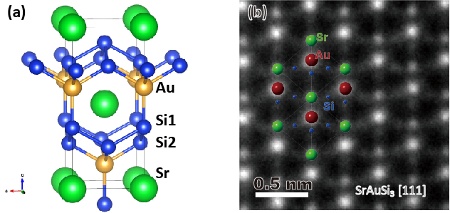Discovery of a novel gold-based superconductor

Crystal structure (a) and scanning transmission electron microscope lattice image (b) of SrAuSi3 Copyright : National Institute for Materials Science (NIMS)
Led by Masaaki Isobe, a team consisting of Hiroyuki Yoshida, Koji Kimoto, Masao Arai and Eiji Muromachi recently searched for novel substances that lack spatial inversion symmetry in their crystal structures.
They successfully synthesized a new compound, SrAuSi3, and found that it exhibits superconductivity at an absolute temperature of 1.6 K (-271.55°C). This compound belongs to a group with a so-called BaNiSn3-type structure (general chemical formula: AMX3, where M represents a transition-metal element).
Up until now, research on superconductivity with broken spatial inversion symmetry has mostly focused on compounds that contain a relatively heavy element M, such as rhodium (Rh), iridium (Ir), and platinum (Pt).
However, using a high-pressure synthesis method, the team successfully synthesised for the first time a compound with the same general chemical formula but using gold (Au), which is even heavier, as element M.
One of the predicted properties associated with superconductivity with broken spatial inversion symmetry is the extremely high upper critical field (the maximum magnetic field value at which superconductivity is sustained).
The discovery of this substance is expected to contribute not only to an understanding of the mechanism involved in superconductivity with broken spatial inversion symmetry but also to the development of new superconducting materials that can be used in a magnetic field.
The results of this research were published in the March 25, 2014 issue (Volume 6, Issue 6) of Chemistry of Materials, a journal distributed by the American Chemical Society.
Associated links
Media Contact
All latest news from the category: Materials Sciences
Materials management deals with the research, development, manufacturing and processing of raw and industrial materials. Key aspects here are biological and medical issues, which play an increasingly important role in this field.
innovations-report offers in-depth articles related to the development and application of materials and the structure and properties of new materials.
Newest articles

Combatting disruptive ‘noise’ in quantum communication
In a significant milestone for quantum communication technology, an experiment has demonstrated how networks can be leveraged to combat disruptive ‘noise’ in quantum communications. The international effort led by researchers…

Stretchable quantum dot display
Intrinsically stretchable quantum dot-based light-emitting diodes achieved record-breaking performance. A team of South Korean scientists led by Professor KIM Dae-Hyeong of the Center for Nanoparticle Research within the Institute for…

Internet can achieve quantum speed with light saved as sound
Researchers at the University of Copenhagen’s Niels Bohr Institute have developed a new way to create quantum memory: A small drum can store data sent with light in its sonic…





















